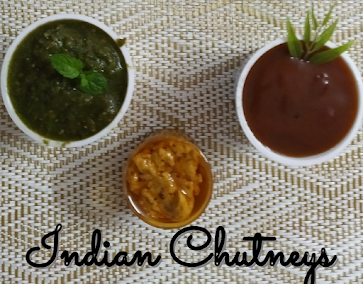Chutneys in India are magical potions which enhance the taste of every dish. These can easily make an average dish a yummy dish and a tasty dish to a mind blowing one. Believe me, their role is not less than the spices that give the taste to the dish, but they never get the credit which they actually deserve. Chutney is derived from the Hindi word chaat which literally means ‘to lick’ the same way they are taken in a very small amount like two spoons to the max as an excess of these could make a dish super hot and spicy.
Chutneys are associated with all types of foods found in India. Like a particular
dish has specific spices to give the taste to it, the same way all Indian chutneys can
not be associated with all Indian dishes. Few Chutneys are region specifics and
few are popular pan India. For example, green chutney made from coriander and mint
with some local species is popular pan India and can be consumed with almost
all the dishes (dry or gravy) in north India and on the other hand coconut chutney
is popular in south India and blends pretty well with almost all south Indian
snacks and dishes.
History:
Chutneys could be dated back to 500 BC and they are linked to Indus
valley civilization. According to Mr. K. T. Achaya (born Oct 6th, 1923 and who was a chemist, food scientist, nutritionist and food historian) ‘Arakallu’
or stone grinders were excavated by the archaeologist at the Indus valley
civilization archaeological sites and in the ancient days chutneys were
prepared by the stone grinders and the same tools are still used in most of southern
Indian states where women prefer to use the stone grinder at the place of the electronic
grinders.
Preparation
and serving:
All chutneys aren’t prepared from a single method. Some are cooked over the stove, some are prepared from the fresh herbs ground with the local spices. Their preparations are region specific, like in north India mostly all chutneys are prepared from the fresh herbs and served at room temperature and in southern India mostly these are prepared by roasting the spices over the stoves and then ground them with the herbs or vegetables available and then a sizzling hot ‘tadka’ meaning 'tempering' is placed on the top of the freshly prepared chutney. Mostly all chutneys are served in a small bowl with a teaspoon along with the dish or food.
Now:
In the current era their importance has increased a lot, as nowadays these are treated as a taste enhancer and have become an integral part of the dish. Today people have become habitual of these chutneys and one or two are found in every Indian house. In the same way at Indian restaurants, food is always accompanied or served with one or two chutneys along with few pickles. For example, green chutney is must have in almost all north Indian kitchens, on the other hand in the south two heavyweights coconut and tomato chutneys are enough to enjoy idli, dosa and vada without needing sambar or any gravy.



Comments
Post a Comment